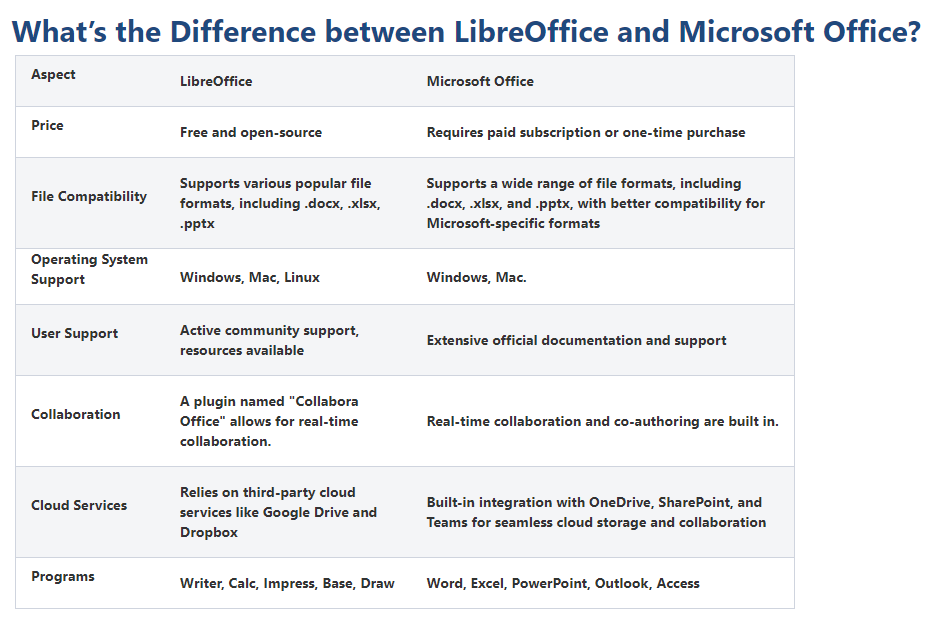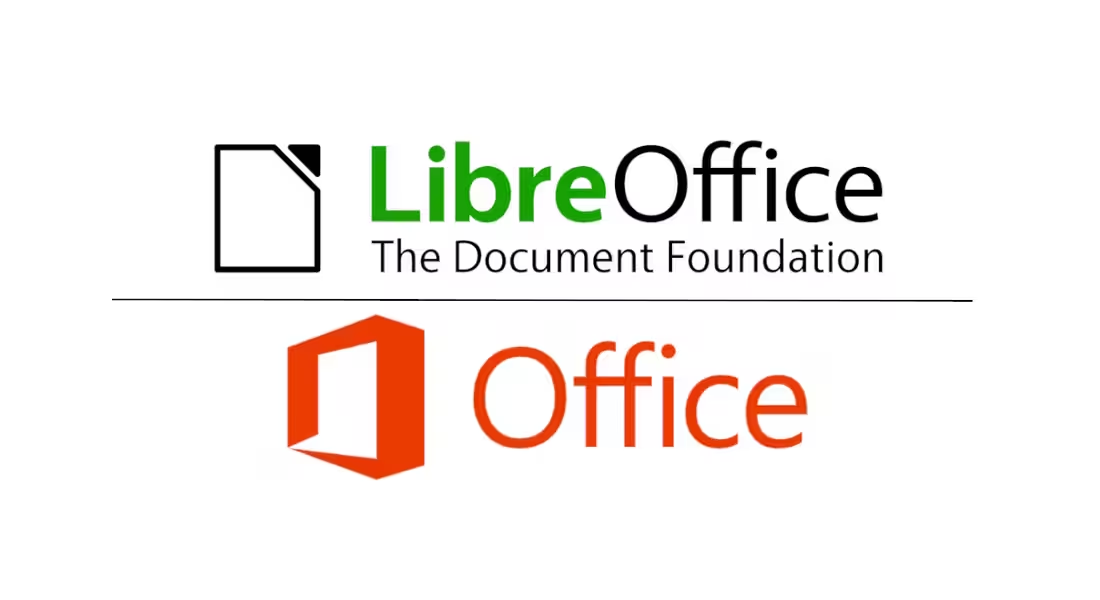Among the numerous office software suites in the open market, LibreOffice, OpenOffice and Microsoft Office are the relatively popular and creditable ones. In today’s tutorial, 123BuyOnline will compare LibreOffice vs Microsoft Office, which will be the most handy and professional office suite that meets your needs to the largest extent?

How Office Productivity Suites Began
The office suite came hot on the heels of the success of the earliest word processor and spreadsheet programs. These bundled the most-used types of office software into coherent families of software. Gone were the days of running a disparate collection of software on your desktop. The dominant programs at the peak of the pre-suite period were the Lotus 1-2-3 spreadsheet, the WordPerfect word processor, and the dBase database program. Notably, Microsoft even made a word processor for kids called Creative Writer.
Office productivity suites completely changed the software landscape for the corporate PC. Instead of a set of unrelated standalone packages, an office productivity suite had a consistent look and feel, with easy integration between those packages. Costing less than the sum total of a mixed set of similar packages, the office suite took off and never looked back.
The package office suite that rose to dominance was Microsoft Office. It was released in November 1990 and included Microsoft Word, Microsoft Excel, and PowerPoint. There were many competing office suites—from companies such as Lotus, IBM, and Corel—but none came close to repeating the success of Microsoft Office.
StarOffice was an office productivity suite developed by a German company called Star Division. They were acquired by Sun Microsystems. A year later, Sun released the StarOffice source code as an open-source product called OpenOffice.org. StarOffice was still sold and developed—benefiting from code contributions made by the OpenOffice.org community—and eventually reached around 100 million users.
OpenOffice.org contained a Word processor called Writer, a spreadsheet called Calc, a presentation application called Impress, and a database front-end tool that could be used with different back-end database engines. OpenOffice.org also included a tool for composing mathematical equations. OpenOffice.org grew to be the open-source counterpart to Microsoft Office. It became the default office suite in the majority of Linux distributions. It’s still available with versions for Linux, Windows, and macOS.
In 2010, Oracle Corporation acquired Sun Microsystems. By 2011, Oracle Corporation was looking to offload the OpenOffice.org open-source project. They struck a deal with the Apache Foundation, and Apache OpenOffice was born. Differences of opinion within the Apache OpenOffice community led to many Apache OpenOffice developers forming a new organization called The Document Foundation. They forked the OpenOffice.org code and created their own project called LibreOffice. LibreOffice nows ships as the default office suite application on most Linux distributions and the dominant open-source productivity software.
The question remains, however: can a free productivity suite really compete with the de facto corporate standard?
LibreOffice vs Microsoft Office
There are several ways to obtain Microsoft Office. You can buy it, and install it on your desktop. You can take out a Microsoft 365 subscription that includes Microsoft Office. You still get applications to run on the desktop, but as long as you maintain your subscription your software will always be upgraded to the latest version.

LibreOffice is free. You can download and install it and start using it. It is desktop only. Microsoft has cloud-based versions of their applications that you can use in your browser. LibreOffice does not offer anything like that, nor does it bundle cloud storage as Microsoft does.

Microsoft Office runs on Microsoft Windows, macOS, iOS, and Android (and there are workarounds for installing Office on Linux). LibreOffice runs on Windows, Linux, and macOS, including a new experimental build compiled for Apple Silicon processors.
Microsoft Office includes:
- Word: Word processing program.
- Excel: Spreadsheet program.
- PowerPoint: Presentation software.
- OneNote: Note-taking software.
Depending on which version you buy or subscribe to, you will also get some or all of these packages:
- Outlook: An email client.
- Teams: A team communication and collaboration client.
- Publisher: A desktop publishing program.
- Access: A database management system. By default, it uses the Microsoft Jet database engine.
- Skype for Business: Instant messenger and video call software.
LibreOffice includes these applications:
- Writer: Word processing program.
- Calc: Spreadsheet program.
- Impress: Presentation software.
- Draw: Vector graphics application.
- Base: Database management system. By default, it uses the HSQLDB but work is afoot to migrate to Firebird. You might need to install Base separately. On many Linux distributions, it’s not part of the core LibreOffice offering.
If you need functionality that isn’t included in LibreOffice—such as an email client, desktop publishing application, or a messaging and collaboration program—you have many open-source options to choose from including well-known examples such as Thunderbird, Scribus, and Rocket.Chat. Of course, they won’t have the same look and feel as the rest of the office suite, and they won’t be tightly integrated.
Fundamental Differences
Perhaps the biggest over-arching difference between the two office suites is their radically different approaches to cloud storage. LibreOffice doesn’t do cloud natively, although The Document Foundation has worked on something called LibreOffice Online. This is a tool for cloud providers—public or private—to incorporate into their offerings. It needs to be integrated with authentication and storage solutions to be functional. At the time of writing LibreOffice Online is frozen, pending further announcements.
Depending on your workflow and how often you move between different computers, cloud integration may or may not be important to you. If you need to achieve it with LibreOffice you can save documents to a local folder that is synced to the cloud storage of your choice. But you must set that up yourself, outside of LibreOffice.
Microsoft Office lets you save locally or to your OneDrive storage natively and naturally, from within the applications. Microsoft also provides online versions of the core office suite applications so you can be productive even when you’re away from your regular computer.
LibreOffice has partial support for Microsoft Visual Basic for Applications macros. LibreOffice has its own macro language, of course, but supports most of the VBA common usage patterns too. Macros aren’t exactly mainstream usage though. Most people want to write documents, crunch some numbers, and give a presentation.
For the average user of office applications, function for function you’ll see little difference between Word and Writer. Some things are easier in Word and more intuitive, such as working with tables of contents and other front matter. The reverse is true for others; LibreOffice handles styles in a more accessible and logical fashion, for example.
LibreOffice Writer is a word processor that happens to be able to read and write Word file formats. That doesn’t mean it is going to be a Word clone. Writer doesn’t try to mimic Word’s terminology or menu structure. It has its own way of doing things. People who are muscle-memory familiar with Word will find themselves at the bottom of a learning curve when they try Writer. It’s not difficult to pick up, but Writer isn’t a drop-in replacement for Word.
Calc is a powerful and competent spreadsheet, and in all but the most advanced cases will do what Excel can do. The graphs are a little lackluster unless you put in some effort, and pivot tables are easier in Excel, but an Excel user will feel at home right away. One point to note is Calc spreadsheets can have as many rows as an Excel spreadsheet (1,048,576), but only 1,024 columns compared to 16,384 in Excel.
Impress used to be the weakest element of the three. It did its job just fine, but it withstood comparison with its Microsoft Office counterpart, PowerPoint, very poorly. It still doesn’t have PowerPoint’s pizazz, but it can handle large and complicated presentations and all the test presentations we created with PowerPoint ran through Impress perfectly. By comparison, Google Slides struggled with slides that had animations placed on lines of text.
Differences in Appearance
In the past, LibreOffice regularly drew criticism for its appearance. Its interface had an early-2000’s vibe—if not earlier. That’s not the case anymore. Selecting
View > User Interfaceopens the “Select Your Preferred User Interface” dialog box.
This lets you keep the traditional LibreOffice menu bar, or choose something that is “the most similar to the Ribbon used in Microsoft Office.”

There are five other options that give variations on tabbed and grouped menu layouts, with compact options for smaller screens. Being able to look like Microsoft Office’s ribbon helps Word users, but the underlying commands still retain their LibreOffice uniqueness.
You can apply a single user interface to a single application or to all LibreOffice applications en masse. If you wanted to, you can have a different user interface style for each application.
Sharing Documents With Microsoft Office Users
If all you ever use is LibreOffice, and you share documents with other LibreOffice users, you’ll have no problems whatsoever. If you need to share documents with Microsoft Office users and they don’t need to edit them, send them as PDF. When you need to share documents with Microsoft Word users who edit the document and send it back to you, problems may arise.
LibreOffice’s native file format follows the Open Document Format, and Writer’s default file format is Open Document Text. Microsoft uses its own Office Open XML format. They’re both XML-based document formats. Microsoft Word can read LibreOffice ODT file formats, but its accuracy isn’t great. LibreOffice Writer can save and read Microsoft’s DOCX and formats—and does a better job than Word does with ODT files—but differences may creep in with complicated documents.
Below is a screenshot of a document with automatically numbered sections and paragraph numbering. This section includes a table that has a list in one table cell. The document was created in Word, and here it is loaded into Word.

This is the same document loaded into LibreOffice:

LibreOffice 7.2.2 has had hundreds of fixes contributed to it specifically to improve the fidelity of its reading and writing DOCX files. If you must collaborate on documents with Word users, you’ll get the best results by starting your document as a DOCX and saving it in that file format throughout. If you’re not going to share documents, stick to the ODT file format for faster load times and smaller files.
In our testing—using the DOCX file format—test documents created in Word loaded into Writer and vice versa loaded and edited perfectly. We used LibreOffice 7.2.2 and Microsoft Word for Microsoft 365 MSO (version 2108 build 16.0.14430.20154), on Windows 10.
That’s all indicative of the great strides that have been made in LibreOffice regarding compatibility. But it doesn’t mean small differences won’t show up due to things like different fonts. Linux doesn’t come with the Microsoft fonts, so documents that use Calibri et al won’t render correctly.
You can install the
ttf-mscorefontspackage for your distribution to obtain Arial, Times Roman, Verdana, and so on. Arch Wiki also offers some alternative methods if that package isn’t available to you. That helps, but there’s no official, licensed way to install the newest Microsoft fonts in Linux.
A Comparable and (Mostly) Compatible Suite
If you don’t need to collaborate on documents or spreadsheets with Microsoft Office users, LibreOffice will satisfy the needs of anyone looking for a fully-featured, mature office suite.
If you do need to share and edit docs with Microsoft Office users, watch out for the gotchas with fonts on non-Windows platforms, and other formatting glitches that can creep in. Things are a lot better than they were, but complicated document layouts and power user spreadsheets can still pose problems.


